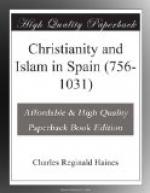Even bishops did not shrink from conforming to this Semitic rite,[4] whether voluntarily, or under compulsion, we cannot say; but we know that the Mohammedan king, under whom this occurred, had at one time the intention of forcing all his Christian subjects to be circumcised.[5]
Another sign of an approximation made by Christians to the outward observances of Moslems, was that some among them thought it necessary to abstain from certain meats,[6] those, namely, forbidden by the Mohammedan law.
A bishop, being taxed with compliance of this kind, gave as his excuse that otherwise the Christians could not live with the Saracens.[7] This was, naturally, not considered a good reason by the stricter or more bigoted party, who regarded with alarm and suspicion any tendency towards amalgamation with Mohammedans. If we can credit certain chroniclers, a council was even held some years before this time by Basilius, Bishop of Cordova, for considering the best method of preventing the contamination of the purity of the Christian faith by its contact with Mohammedanism.[8]
[1] See John of Cordova, in
the “Life of John of Gorz,” above,
p. 89.
[2] Alvar, “Ind. Lum.”, sec. 35.
[3] Romans ii. 29; Galatians v. 2.
[4] See “Life of John of Gorz,” sec. 123.
[5] See “Life of John of Gorz,” sec. 123; Samson, “Apolog.,” ii. c. 4. Cp. “Loys de Mayerne Turguet,” xvii. 13. The king, Halihatan (Abdurrahman III.), 950 published an edict, “par lequel il estait mande a tous Chrestiens habitans es terres et villes a luy subjectes de laisser la religion de Jesu, et se faisans circoncire prendre cette de Mahomet, sur peine de vie.”
[6] See Appendix B, p. 167;
and Koran v. ad init.—” You
are
forbidden to eat that which
dieth of itself, and blood, and
swine’s flesh ... and
that which hath been strangled.”
[7] “John of Gorz,” 1.1.
[8] “Pseudo-Luit.”, sec. 341. Cp. “Chron. Juliani,” sec. 501. “Viritanus coegit concilium Toleto ad inveniendum remedium ne Muzarabes Toletani, imo totius Hispaniae, Saracenis conjuncti, illorum caeremoniis communicarent.”
Sometimes, however, the contact with Islam acted by way of contraries, and Christian bigots, such as the monks often were, would cling to some habit or rite of their own from a mere spirit of opposition to a reverse custom among Moslems. Thus we know that the monks in the East became the more passionately devoted to their image-worship, because Iconoclasm savoured so much of Mohammedanism. In the same way, but with far more objectionable results, the clergy in Spain did their best to impress the people with the idea that cleanliness of apparel and person, far from being next to godliness, was incompatible with it, and that baths were the direct invention of the devil.[1] Later on we know that Philip II., the husband of our Queen Mary, had all public baths in his Spanish dominions destroyed, on the ground that they were relics of infidelity.[2]




